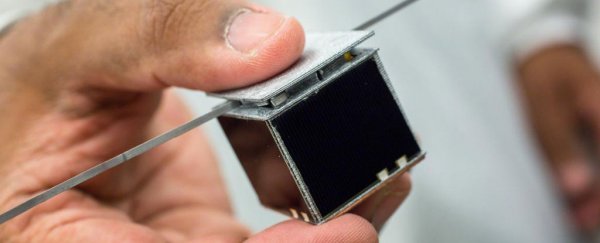How much do you think a typical spacecraft costs? Millions, or even billions, of dollars? If you're talking about the kinds of vehicles in NASA's fleet, you're right, but what if you reduced the scale to, say, the dimensions of a Matchbox car? That would make things a lot more affordable, right?
That's the thinking behind an ambitious new satellite concept developed by scientists at Arizona State University (ASU). Their tiny SunCube platform is what's called a femtosat – aka femtosatellite, meaning an extremely small satellite that weighs less than 100 grams in total (and that's including any mini payload or fuel).
On the scale of miniaturised satellites, the femtosat is as tiny as it gets – smaller than microsatellites (10–100 kg), nanosatellites (1–10 kg), and picosatellites (100 grams to 1 kg). And those humble proportions would make the SunCube not only cheaper to build, but also substantially cheaper to launch, hypothetically bringing personal space exploration – space exploration! – within reach of pretty much anybody.
"With a spacecraft this size, any university can do it, any lab can do it, any hobbyist can do it," says lead researcher Jekan Thanga, head of the Space and Terrestrial Robotic Exploration (SpaceTREx) Laboratory at ASU.
The SunCube measures just 3 centimetres in each direction, and because it weighs next to nothing, the launch costs are amazingly approachable. The team says it would cost about US$1,000 to send a SunCube to the International Space Station (ISS) or $3,000 to venture into low-Earth orbit.
Getting one into outer space would be slightly more exxy at about $27,000, but compared to conventional launch costs running at around $60,000-$70,000 per kilogram, it's decidedly doable.
The scientists announced the SunCube at an ASU event this week, and their paper explains how the technology could provide a viable standard for anybody interested in getting personally involved with space science.
Obviously, modules this small made up of parts only costing a few hundred dollars won't be zinging past Pluto any time soon, but equipped with a radio, sensors, cameras, and tiny solar panelling to provide a continuous power source, you've got the makings of a spacecraft that could monitor Earth or other bigger satellites or space stations, or could be used by students and enthusiasts to send tiny experiments into space.
"There's a whole community out there interested in this idea of low-cost, swarms of disposable spacecraft," said Thanga. "It's like your own GoPro in space. That would give you quite the front-seat view in space."
Of course, it's early days for this idea of mass-participation space exploration, so we can't get too carried away. Miniaturised satellites at this level are very much a new thing, and before we start launching hundreds of tiny cubes into space, there'll be all sorts of questions for scientists to figure out. (We don't want to add to the space junk problem, for example.)
But the team at ASU is excited by the possibilities. Thanga, who envisions femtosats like the SunCube being sold on Amazon one day, says access to space for everybody could be the future of astronomy.
"We can show the world we can fly in space," he said. "Being an active person involved in a space mission – it's the next domain in exploration."
